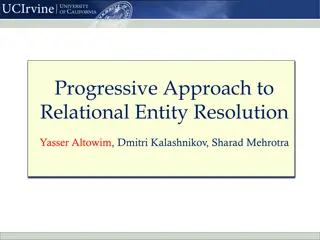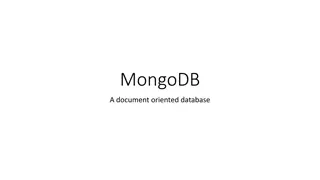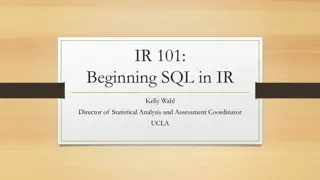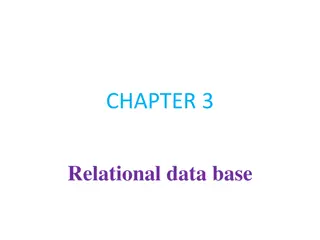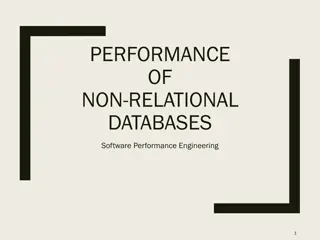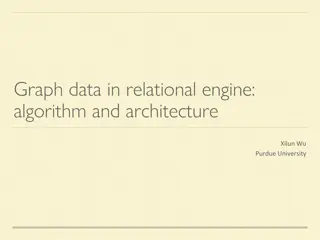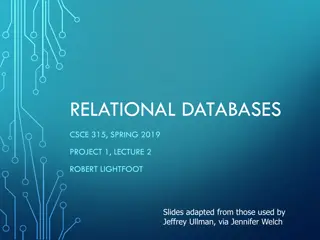
Data Models in Computer Science
Data models are essential for representing and managing data in computer systems. They provide a structured way to conceptualize and organize data, such as in relational, graph, tree, and JSON formats. This summary explores various data models, including their uses and examples, such as the relational model for databases and JSON for data exchange over the internet.
Download Presentation

Please find below an Image/Link to download the presentation.
The content on the website is provided AS IS for your information and personal use only. It may not be sold, licensed, or shared on other websites without obtaining consent from the author. If you encounter any issues during the download, it is possible that the publisher has removed the file from their server.
You are allowed to download the files provided on this website for personal or commercial use, subject to the condition that they are used lawfully. All files are the property of their respective owners.
The content on the website is provided AS IS for your information and personal use only. It may not be sold, licensed, or shared on other websites without obtaining consent from the author.
E N D
Presentation Transcript
CS143 Relational Model Professor Junghoo John Cho
Data Model Q: What is a data model? Why do we need it? A: Data model is a way we model/conceptualize/represent data We need a concrete representation to manage data in a computer Many different ways to model data Graph model, tree model, object model, 2
Graph Model (= Network Model) Nodes, edges and labels Airline flights SFO UA35, 3PM NYC AA24, 10AM DL09, 10PM LAX 3
Tree model (= Hierarchical Model) Nodes, edges, and labels arranged in a tree Company hierarchy CEO President VP VP VP Director Director Director Director 4
Relational Model All data is represented as a set of tables The most popular data model used for database systems Example: School information Student(sid, name, age, GPA, address, ) Class(dept, cnum, sec, title, instructor, ...) Enroll(sid, dept, cnum, sec) ... sid name addr age GPA 301 John 183 Westwood 19 2.1 303 Elaine 301 Wilshire 17 3.9 401 James 183 Westwood 17 3.5 5
Example: JSON (JavaScript Object Notation) Syntax to represent objects in JavaScript [{ x : 3, y : Good }, { x : 4, y : Bad }] One of the most popular data-exchange formats over Internet As JavaScript gained popularity, JSON s popularity grew Simple and easy to learn Others popular formats include XML, CSV,
Basic JSON Syntax Supports basic data types like numbers and strings, as well as arrays and objects Double quotes for string: Best , UCLA , Worst , USC Square brackets for array: [1, 2, 3, four , 5] Objects: (attribute, name) pairs. Use curly braces { sid : 301, name : James Dean } Things can be nested { sid : 301, name : { first : James , last : Dean }, classes : [ CS143 , CS144 ] }
Data Model of JSON? Q: What is JSON s data model? Tree (hierarchical)? Graph (network)? Relational? { sid : 301, name : { first : James , last : Dean }, classes : [ CS143 , CS144 ] }
History of Relational Model By far, the most significant invention in the history of DBMS E.F. Codd, 1970 Completely revolutionized the field Turing Award, 1981 Extremely simple Another evidence of the power of a simple yet widely-applicable idea in computer science Initial research prototypes IBM System R IBM DB2 Berkeley Postgress PostgresSQL IBM and Oracle: first commercial RDBMS vendor. Still dominates the market together with Microsoft 9
Relational Model: Terminology sid name addr age GPA 301 John 183 Westwood 19 2.1 303 Elaine 301 Wilshire 17 3.9 401 James 183 Westwood 17 3.5 Each relation has a set of attributes (= columns) Each relation contains a set of tuples (= rows) Each attribute has a domain (= type) Only atomic types Data representation is very similar to Excel spreadsheet 10
Terminology Schema: the structure of relations in database Relation name, attribute name, domain (optional) Example: Student(sid, name, addr, age, GPA) Instance (= Data) Actual content of relation Schema variable type, Instance value 11
Terminology Keys: A set of attributes that uniquely identifies a tuple in a relation Student(sid, name, address, GPA, age) Course(dept, cnum, sec, unit, instructor, title) Underline key attributes in schema Multiple keys are possible Course(dept, cnum, sec, unit, instructor, title) Course(dept, cnum, sec, unit, instructor, title) Q: When do we need keys? How can they be used? 12
Name Scope Name of a relation is unique across relations Name of an attribute is unique in a table Same attribute name in different tables is OK 13
Set Semantics No duplicate tuples are allowed in relational model Duplicates tuples are allowed in SQL for practical reasons. More on this later Q: Can a relation with no duplicates have no keys? Tuple order does not matter Attribute order does not matter In SQL, attribute order does matter, but not in pure relational model 14
Null Value Common interpretation Do not know/Do not want to say/Not applicable Example Student(id, major, name, GPA) What GPA value before the first quarter? 15
Complications from Null Student (id, major, name, age, GPA) sid name addr age GPA 301 John 183 Westwood 21 2.1 303 James 301 Wilshire NULL 3.9 401 Susan 183 Westwood 17 3.5 Q1: students with age >= 20 Q2: students with age < 20 Q3: students with age >= 20 or age < 20 Due to NULL, DBMS may return unexpected answers 16
Null and SQL 3-valued logic Every condition is evaluated as True, False or Unknown Concrete rules to deal with Null and Unknown values Nulls and SQL 3-valued logic adds significant complexity to DBMS implementation and execution 17
Five Steps in Database Construction Domain Analysis Database Design Table Creation Load Query and Update 18
Structured Query Language (SQL) The standard language for interacting with RDBMS Many versions of SQL standard exists SQL89 (Ansi SQL): first standard SQL92 (SQL2): the main standard, several hundred pages SQL3 (SQL99): no vendors supports it all exactly! 1600 pages SQL4(SQL03): bug-fix release In our lectures, we mostly use SQL92 standard Individual DBMS product may use a slightly different syntax, but will be mostly the same 19
SQL SQL has many components Data Definition Language (DDL): schema definition, constraints, Deta Manipulation Language (DML): query, modification, ... Transaction, Authorization, ... We cover schema definition part in the rest of the today s lecture 20
Basic SQL Data Types (commonly used subset) String Char(n) padded fixed length Padding character is system dependent (space for Oracle, auto-removed for MySQL) Varchar(n) variable length Number Integer 32 bit Decimal(5,2) 999.99 Real, Double -- 32bit, 64bit Datetime Date 2010-01-15 Time 13:50:00 Timestamp 2010-01-15 13:15:00 On MySQL, Datetime is preferred to Timestamp 21
SQL Table Creation Course(dept, cnum, sec, unit, instructor, title) 22
SQL Table Creation CREATE TABLE statement One PRIMARY KEY per table UNIQUE for other keys PRIMARY KEY and UNIQUE are enforced through index (more on this later) No Null for PRIMARY KEY attributes. Null OK for UNIQUE (in SQL92) MySQL automatically adds NOT NULL to PRIMARY KEY attributes DEFAULT to set the default value for an attribute DROP TABLE statement for deleting a table 23
Bulk Loading Data into Table No SQL standard for bulk data loading MySQL (and Oracle) LOAD DATA LOCAL INFILE <data-file> INTO TABLE <table-name> 24
What We Learned Data model Schema and data instance Relational model Relation, attribute, tuple, domain Key Null value Set semantic 5 steps for database construction Domain analysis, database design, table creation, load, query & manipulation SQL table creation and bulk data loading 25

